2012 Arctic Cat ProCross F800 LXR Review

F800 series will be the choice of flatland riders
Arctic Cat makes choosing the “right” sled for flatlanders a bit tricky. First, let’s agree that we want the twin cylinder 800cc two-stroker. Obviously we want that 160-horsepower twin under the new narrow profile hood of the 2012 ProCross series F800. The tricky part is which version do we go with? While similar in most respects, the F800 comes in either the Sno Pro or LXR version.
Engine Type:Horizontal In-line
Cylinders:2
Engine Stroke:2-Stroke
Valve Configuration:Reed Valve
Displacement:794 / 48.4
Starter:Electric
Turbocharged:No
View Full SpecYounger aggressive riders will man up for the Sno Pro. Seasoned riders may look long and hard at that version, but they will settle in with the F800 LXR. It’s all Arctic Cat sport sled, but less of an edge and more refinement. We’ll give up the Fox Float 2 ski shocks in favor of the LXR’s easier to maintain Fox Zero Pro front shocks. The rear suspension is virtually the same except for the large 2-inch diameter rear shock for the nastiest big bumps. And, really, that is the marketing difference between the two models. The Sno Pro is designed for the rider who seeks out the biggest bumps. The LXR suits the rider who wants some big bump action, but puts a bigger premium on comfortably handling long miles and a wide variety of terrain.
We’d opt in for the 2012 Arctic Cat F800 LXR. Since both of these all-new 2012 models are essentially the same, we’d go for the long haul features and less aggressive ride and handling.
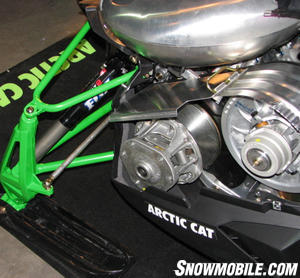 Cat engineers moved the drive, exhaust and steering toward the center for handling and stability.
Cat engineers moved the drive, exhaust and steering toward the center for handling and stability.
The F800 would be our Cat of choice because we haven’t turned totally “green” and have no guilt in riding a sled with the two-stroke option. We don’t have anything against the “greener” options of the Arctic Cat four-stroke powerplants. Indeed, the turbocharged four-stroke is amazing in a straight-line and the non-turbo version is competitive with the existing 600cc two-stroke twins. But we’ve been big admirers of the Suzuki-built 800cc powerplant used in many Arctic Cat models ever since it was introduced. Arctic Cat set a trend in motion that sees every other 800 category two-stroke twin emulating it. What Cat did was establish a new level of across-the-board performance that gives modern day snowmobilers the top end and hard hit of the traditional 800cc powerplant combined with the easy to use character of a 600 two-stroke. The Cat’s 800 twin is at home in slow speed twisty trails as it is rambling full throttle across a snow-packed lake. This is the engine that convinced us to get over our predilection for 600-class sleds. The new breed of 800 two-strokes gives snowmobilers the best of all worlds.
Arctic Cat’s Suzuki-built twin measures 794cc with a bore and stroke of 85mm by 70mm. Those dimensions suggest strong bottom end from an engine designed for torque. While the horsepower rating from the liquid-cooled two-stroke comes in at a claimed 160-hp, you can expect strong torque for super-quick exits off a turn.
If you like that kind of action, you might want to rethink the LXR versus the Sno Pro. The standard track for the LXR is the Hacksaw profile with a one-inch tall lug. The Sno Pro comes with a slightly grippier Ripsaw track and taller 1.25-inch lug height. That’s a choice you need to consider when looking at the LXR.
The good news is that the power to the track can be controlled extremely well as the 800 twin features a very responsive electronic fuel injection system that works via dual 46mm throttle bodies. Of course, the 2012 Arctic Cat F800 series engine is more than EFI and large-volume throttle bodies to push fuel. It’s quite a sophisticated motor with electronically controlled Arctic Power Valves on the two-into-one exhaust system. You’ll find an exhaust pipe temperature sensor returning information to the central computer processor to help the engine give you maximum efficiency cycle after cycle. All of this tuning technology has been proven on the racetrack and backed up by miles of Arctic Cat seat-of-the-pants on-snow testing.
The 800cc twin delivers power to a revised clutch drive that features Arctic’s own 6-post rpm sensing drive and a 10.75-inch diameter roller cam driven. If you ever get a chance to see a “naked” 2012 ProCross chassis at a snowmobile show, check out how Arctic Cat engineers mounted the drive system, keeping it centered for maximum weight balance. This new F800 takes advantage of 50 years of tried, tested and retested engineering. It is the culmination of five decades of things that work the best.
Among those things is the cockpit. Sit on the F800 series and feel how the sled comes together in your hands, your feet and your fanny. The handlebar curves to fit how you ride, how you settle into corners and how you push back for a long straight. The seat looks a bit odd, but those curves and tip down front slope get you settled into the sled. You can slide easily into a corner. The curved sides let you move easily from left to right and back. And your feet fit easily into the footwells and have ample room along the runningboard. This is a sled designed for snowmobiling by serious snowmobilers. Arctic Cat may make ATVs, but snowmobiling makes up a huge part of Arctic Cat’s DNA. You sense it when you sit on the sled.
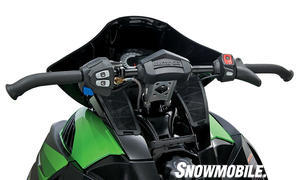 The Cat “curve” in its handlebar works well in a straight line but excels for cornering.
The Cat “curve” in its handlebar works well in a straight line but excels for cornering.
The F800 looks different. You wonder if it works. After all no one else has A-arms that are as tall as those on the ProCross series. There’s a “spidey” sense to the way the F800 sits on the snow. The front end shares the Arctic Wishbone Suspension in concept, but the new ARS (Arctic Race Suspensions) is different. But different works. The sled is light and very responsive as the long arms brace the single runner skis for whatever awaits you when you turn into a corner. For LXR riders the Fox Zero Pro shocks with their internal floating piston will help hold your line. The standard sway bar will help keep the chassis’ front end flat and transfer action from the inside ski to the outer ski.
When we first rode the new ProCross chassis we didn’t know what to expect. Familiar with the old Cat design, we knew our limitations with it. The ProCross and the ARS front suspension were new and we needed to gain confidence in how it would handle. Well, that’ll be a very short learning curve let us assure you! This sled is light and very “flickable” through the corners.
The back end follows around as you would expect from the already proven Arctic Cat FasTrack rear suspension. The 2012 version for the ProCross chassis has been slightly revised as a result of having to fit into a new sled. Other than how it fits in the sled, the FasTrack suspension remains as before, which means it has Cat’s slide-action technology with a system of coupling blocks to help balance weight transfer upon acceleration and deceleration when braking. The tuning is simple with the torque-sensing linkage and torsion springs. As noted the LXR relies on Fox shocks for ride control. Regardless of model, both the Sno Pro and LXR feature 10 inches of front suspension travel and 13.5 inches at the rear.
While the LXR gets the mid-height windshield, you’ll so enjoy the easy key starting. Electronic push button reverse is standard as is easy-to-reach hand and thumb warmer controls. The F800 series carries up to 10.6 US gallons of fuel and provides sled information courtesy of a deluxe gauge package. The LXR adds the convenience of a rear storage bag.
Although our pick would be the LXR version of the 2012 Arctic Cat F800 series, we wouldn’t turn down a Sno Pro version if it were offered. But, we know that the F800 LXR can handle anything and anywhere we’ll be riding and these days we prefer to pass by the big bumps in favor of adding more miles in a day’s ride. The 2012 Arctic Cat F800 LXR is incredibly well suited to our style of snowmobiling.
| 2012 Arctic Cat ProCross F800 LXR Specs | |
| Engine | Suzuki/Arctic Cat 794cc 2stroke, twin cylinder; liquid-cooled; batteryless EFI with 46mm throttle body |
| Horsepower | 160 (claimed) |
| Drive | Arctic Cat 6-post rpm sensing drive with 10.75-in diameter roller cam driven |
| Front Suspension | Arctic Cat ARS — 10-in maximum travel; Fox Zero Pro shocks with sway bar |
| Rear Suspension | Arctic Cat FasTrack slide rail with coupling blocks — Aluminum-bodied Fox Zero Pro shocks, coupling blocks and adjustable torsion springs; 13.5-in of maximum travel |
| Length | 118.0 in |
| Width | 48.0 in |
| Ski Stance | 42.0-43.0 adjustable |
| Track | 15 x 128 x 1.0 Hacksaw |
| Weight | NA |
| Fuel Capacity | 10.6 US Gal |
| MSRP | US $11,899 |
Related Reading
2012 Arctic Cat F1100 Sno Pro Review
2011 Arctic Cat F8 Review
2010 Arctic Cat F8 LXR Review
2010 Arctic Cat F8 Sno Pro Review



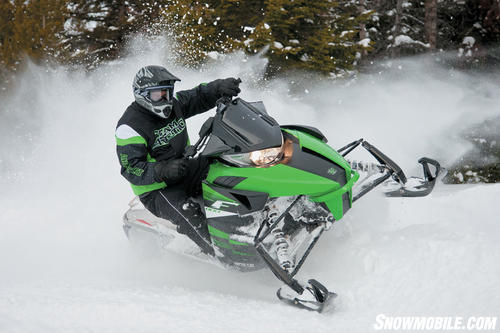
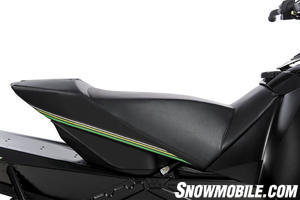
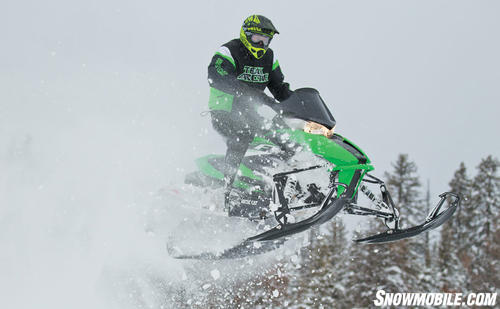
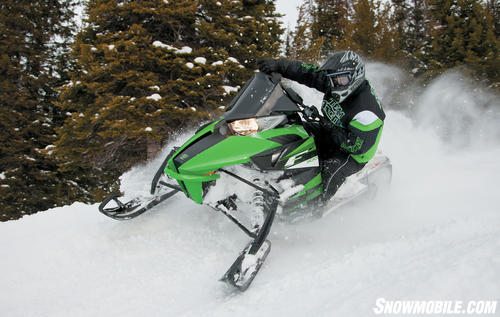
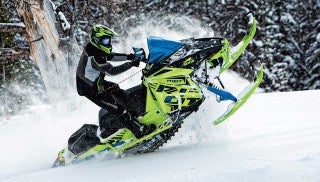




 Your Privacy Choices
Your Privacy Choices